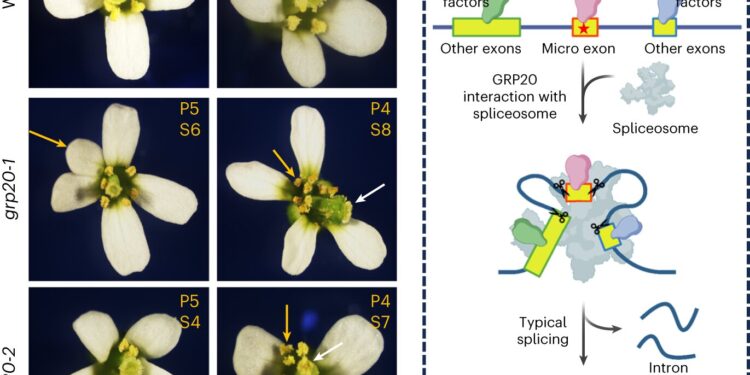Abnormal number of floral organs in grp20 mutants and micro-exon retention regulated by GRP20. Credit: Natural plants (2024). DOI: 10.1038/s41477-023-01606-7
Flowers rely on a newly identified protein to grow properly with all their organs, according to the research team that made the discovery. The team, led by Penn State biologists, identified the protein in the model plant species Arabidopsis and said its mechanism is likely shared between plant species.
They found that the protein helps ensure that the RNAs (molecules that transfer information stored in DNA to produce proteins) in flowers are properly processed. It does this by preventing even the smallest components of the RNA code from being accidentally lost before they can be used to make the corresponding proteins. Some of these proteins are, in turn, necessary for the normal formation of all floral organs, including petals and stamens.
The researchers demonstrated that the protein, necessary for proper flower development, is involved in RNA processing of thousands of genes and likely helps the plant respond to the environment.
An article describing the research appeared in the journal Natural plants.
“The protein we identified in Arabidopsis, called GRP20, helps ensure that thousands of genes are spliced correctly and that even the smallest exons are not missed in this splicing process for crucial floral regulatory RNAs,” he said. said Hong Ma, Huck Chair in Herbal Medicine. Reproductive development and evolution and professor of biology at Penn State’s Eberly College of Science, who led the research team.
RNA can have its own function or carry the genetic code used to generate proteins. However, for most genes, not all of the sequence contained in RNA is used to code for proteins. These RNA molecules must first be processed, a step called splicing, cutting off the non-coding bits and bringing the coding parts together, called exons.
Splicing is carried out by the spliceosome – a molecular machinery containing several proteins and RNA molecules – and is further regulated by other splicing factor proteins. The average length of an exon in plants is 180 nucleotides, the A, T, C, G units that make up DNA.
These exons generally contain specific nucleotide sequences recognized by the splicing machinery, but microexons comprising 50 nucleotides or fewer often lack these sequences.
“Relatively little is known about the mechanisms that control the splicing process of specific sets of RNAs beyond the general process by the spliceosome, particularly for those with micro-exons,” Ma said. Short exons, due to their length, may lack particular sequences that guide proper exon recognition by the splicing machine.”
In addition to the spliceosome and known splicing factors, the researchers predicted the existence of additional specialized proteins to ensure that short exons are not missed in the splicing process.
“GRP20 binds to RNA and interacts with the spliceosome,” said Ma. “We experimentally disrupted the gene encoding this protein in the plant and found that more than 2,000 genes were not properly spliced during of plant development. We specifically found that micro-exons were missing in genes known to be important for floral organ formation and response to environmental changes.”
The researchers identified which part of the GRP20 protein binds to RNA molecules and which part interacts with the spliceosome. They then created versions of the GRP20 protein lacking either the RNA-binding ability or the ability to interact with the spliceosome.
“In both cases, the plants did not develop properly due to the absence of micro-exons in the RNAs encoding proteins important in flower development,” explained Ma. “This suggests that the binding of RNA and interaction with the spliceosome are necessary for the proper functioning of the protein and ensure proper inclusion of micro-exons in RNAs for normal flower formation.”
The researchers further showed that they could rescue flower development by introducing proteins containing all portions encoded by micro-exons, or by introducing a version of the GRP20 gene from another plant species closely related to cabbage and cabbage. canola.
“The discovery that GRP20 is a crucial regulator for RNA splicing will allow us to further explore its function in regulating other molecular, developmental and physiological processes in plants,” said Ma. “Moreover, as The GRP20 protein and many of the genes it helps to splice correctly are conserved across plant species, we believe its role is also conserved and plan to explore its function, and possibly that of other similar proteins, in other other species.”
In addition to Ma, the research team includes Jun Wang, Xinwei Ma, Yi Hu, Guanhua Feng and Xin Zhang of Penn State; and Chunce Guo of Jiangxi Agricultural University in China. The Penn State Eberly College of Science and the Penn State Huck Institutes of the Life Sciences supported this research.
More information:
Jun Wang et al, Regulation of micro and small exon retention and other splicing processes by GRP20 for flower development, Natural plants (2024). DOI: 10.1038/s41477-023-01605-8
GRP20 regulates micro-exon retention via interaction with the spliceosome during flower development, Natural plants (2024). DOI: 10.1038/s41477-023-01606-7
Provided by Pennsylvania State University
Quote: Newly identified protein helps flowers grow properly (February 5, 2024) retrieved February 5, 2024 from
This document is subject to copyright. Except for fair use for private study or research purposes, no part may be reproduced without written permission. The content is provided for information only.



